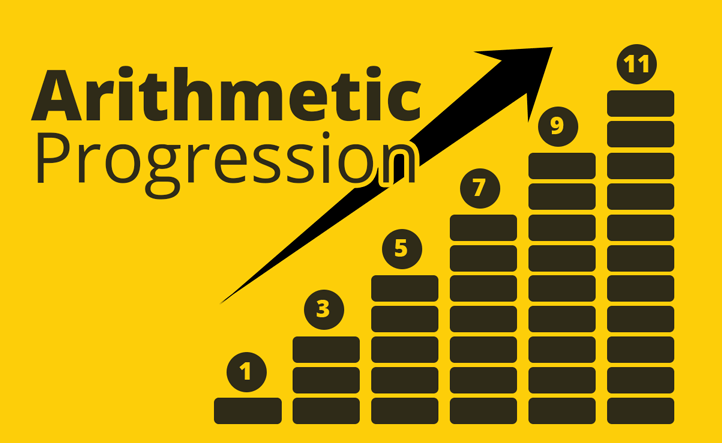Hello dear learners, this time, it's gonna be a Math lesson. To be honest, I didn't like Math before but after watching a great lesson series, I've gain the like and love for Math. And this lesson is one of the main lessons that I like most and I have a very little problems in solving. I'm sure that you too will be able to understand and to solve these and you don't have to be a student to learn these, everyone will need these in daily lives.
Going to the lesson, this time it's Arithmetic Progressions. This belongs to the number patterns.

Let's see what a number pattern is.
Some examples are shown below.
2, 4, 6, 8, ....
5, 10, 15, ....
7, 5, 3, 1, ....
2, 4, 8, 16 ....
4, 9, 16, 25, ....
1, 3, 6, 10, 15, ....
To get the next term in the 1st pattern, we have to add 2 to 8. So we can say that the pattern increases by 2.
To get the next term in the 2nd pattern, we have to add 5 to 15. So we can say that the pattern increases by 5.
To get the next term in the 3rd pattern, we have to subtract 2 from 1. So we can say that the pattern decreases by 2.
The 4th pattern is a different one. It's based on 2's powers. To get the 5th term of this pattern, we have to find the value of 2^5 (two to the power 5) and the result is 32.
The next pattern is a different pattern. This pattern is based on Square numbers. So to get the 6th term of that pattern, we have to multiply 6 by 6 and that's 36.
The next pattern is based on Triangular numbers. So the next term is 21.
So those are some various kinds of number patterns. Let's see what Arithmetic Progressions are.
An Arithmetic Progression is a number pattern which gives the same result when a term of the pattern is subtracted from the term just after that term.
Let's further clarify this.
We can call the 1st example an Arithmetic Progression. The pattern is,
2, 4, 6, 8
Let's take 2 and 4 as the term after it. So when we subtract 2 from 4, the result is 2.
4-2 = 2
Then to check whether it is an arithmetic progression, we have to check whether this goes on for all the terms of that pattern.
6-4 = 2
8-6 = 2
So we can call that number pattern an Arithmetic Progression.
Let's check one more number pattern.
5, 10, 15, 20, ...
10 - 5 = 5
15-10 = 5
20 - 15 = 5
∴ this number pattern is an Arithmetic Progression.
We call the constant value we get after we subtract the after term from the before term the Common difference. This is denoted by 'd'.
∴ d = any term other than the 1st term - the preceding term
Let's find the common difference of these number pattern.
1)4, 8, 12, 16,...
d = 8 - 4
= 4
2) 7 , 5, 3, 1, ...
d = 5 - 7
= -2
I think that it's enough for now. There are lots to learn about these. So look forward to them.
Before you go, I have some questions for you to check whether my teaching is good. So anyone can answer these little questions (either type the solving part or write on a paper and share a photo here) and help me increase my teaching abilities :D
1) Choose the Arithmetic Progressions from the below number patterns and find the common difference of them.
i) 4, 7, 10, 13, ...
ii) 30, 24, 18, 12, ....
iii) 3, 7, 15, 35, ...
iv) 18, 15, 12, 9, ...
v) 125, 25, 5, ...
vi) 2, 4, 8, 16, ...
vii) 6, 10, 14, 18, ...
vii) 160, 240, 360, ....
viii)200, 150, 100, ...
ix) 375, 325, 275, ...
x)-6, 12, -24, ...
Hope you learnt something
--------------------------------------------------------------------------------------------------------
Did you hear about the Teen community me, @mashiliyanage and @justaboutart are working on?
We created the #tos tag which stands for Teens On Steem
So that we can make Steemit a better place for teenagers.
So if you are a teenager, you can also use this tag
Follow our account @teensonsteem
You can join our Discord chat here.
***
Thanks a lot for stopping by
Until we meet again ❤


Great lesson, teacher!!!! ❤
I'll give 3 answers...
D is 3
D is -6
D is x squared minus 1
So next number in the progression...
16
6
48
What's my mark on what I completed? 😀
Posted using Partiko Android
Thank you, dear student 😉
Is 'D is x squared minus 1' the answer for the 3rd question?
I'll give the results right away after you tell me which question.
By the way Kenny, thanks a lot for answering these questions. You might know these before I taught you but I really appreciate your flexibility to spend some time to answer my Qs and to support me :D
Well, that WAS my answer for the third one, but I see now that it doesn't work! :)
And I'm not sure what the right answer is. Unless the 4th number is 31 instead of 35. Then I would have an answer. :) But you stumped me with 3, 7, 15, 35!
Whoops... the pattern should be 3, 7, 15 and 31 instead of 35 as I remember. You've got it right! By the way, we can't take it as an Arithmetic progression. Because the difference is not the same.
Congrats! You've received 2/3 marks! Thanks again for the support :D
Greetings @chamudiliyanage! Your post was randomly chosen and was resteemed because you are one of our followers. Enjoy your free resteem!
Shareables - We resteem anything we find shareable. Always strive for quality content. Go on express and harness your blogging potential!
God bless from us @Shareables!
Thank you ^^
You're welcome @chamudiliyanage!